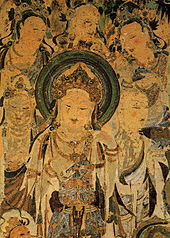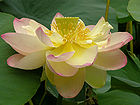- Tiantai
-
Lands India • China • Japan
Vietnam • Korea
Singapore • Taiwan
Tibet • Bhutan • Nepal
Mongolia • United StatesDoctrine Bodhisattva • Śīla
Samādhi • Prajñā
Śunyatā • TrikāyaMahāyāna Sūtras Prajñāpāramitā Sūtras
Lotus Sūtra
Nirvāṇa Sūtra
Saṃdhinirmocana Sūtra
Avataṃsaka Sūtra
Śūraṅgama SūtraMahāyāna Schools Mādhyamaka
Yogācāra
Esoteric Buddhism
Pure Land • Zen
Tiantai • NichirenFor other uses, see Tiantai (disambiguation).Tiantai (Chinese and Japanese: 天台宗; pinyin: tiāntái zōng; ) is an important school of Buddhism in China, Japan, Korea, and Vietnam. In Japan the school is known as Tendai, and in Korea it is known as Cheontae. Tiantai is also called the "Lotus School", due to its emphasis on the Lotus Sūtra as its doctrinal basis. David Chappell writes that the Tiantai school has a reputation for being the most comprehensive and diversified school of Chinese Buddhism.[1] David Chappell frames the broad doctrines of the Tiantai school as being suited to adapt to other cultures, to evolve new practices, and to universalize Buddhism.[2]
During the Tang Dynasty, the Tiantai school became one of the leading schools of Chinese Buddhism, with numerous large temples supported by emperors and wealthy patrons, with many thousands of monks and millions of followers.
Contents
Doctrines
See also: Ten suchnessesThe Tiantai school takes the Lotus Sūtra (Saddharmapuṇḍarīka Sūtra) as the main basis, the Mahāprajñāpāramitā Śāstra of Nāgārjuna as the guide, the Nirvāṇa Sūtra as the support, and the Pañcaviṃśatisāhasrikā Prajñāpāramitā Sūtra for methods of contemplation.[3]
Nan Huaijin summarizes the main teaching of the Tiantai school as the following: the One Vehicle (Skt. Ekayāna), the vehicle of attaining Buddhahood, as the main principle; the three forms of śamatha-vipaśyanā correlated with the meditative perspectives of emptiness, provisional existence, and the mean, as the method of cultivating realization.[4]
The Tiantai school became doctrinally broad, able to absorb and give rise to other movements within Buddhism. The tradition emphasized both scriptural study and meditative practice, and taught the rapid attainment of Buddhahood through observing the mind. The Tiantai school also took up a principle of triple truth derived from Nāgārjuna: phenomena are empty of self-nature, phenomena exist provisionally from a worldly perspective, and phenomena are both empty of existence and exist provisionally at once. The transient world of phenomena is thus seen as one with the unchanging, undifferentiated substratum of existence. This doctrine of interpenetration is reflected in the Tiantai teaching of three thousand realms in a single moment of thought.[5]
Meditation
In China it has been traditionally held that the meditation methods of the Tiantai are the most systematic and comprehensive of all.[6] In addition to its doctrinal basis in Indian Buddhist texts, the Tiantai school also emphasizes use of its own meditation texts which emphasize the principles of śamatha and vipaśyanā.
Of the Tiantai meditation treatises, Zhiyi's Concise Śamatha-vipaśyanā (小止観), Mahā-śamatha-vipaśyanā (摩訶止観), and Six Subtle Dharma Gates (六妙法門) are the most widely read in China.[7] Rujun Wu (1993: p. 1) identifies the work Mahā-śamatha-vipaśyanā of Zhiyi as the seminal meditation text of the Tiantai school.[8] Regarding the functions of śamatha and vipaśyanā in meditation, Zhiyi writes in his work Concise Śamatha-vipaśyanā:[9]
The attainment of Nirvāṇa is realizable by many methods whose essentials do not go beyond the practice of śamatha and vipaśyanā. Śamatha is the first step to untie all bonds and vipaśyanā is essential to root out delusion. Śamatha provides nourishment for the preservation of the knowing mind, and vipaśyanā is the skillful art of promoting spiritual understanding. Śamatha is the unsurpassed cause of samādhi, while vipaśyanā begets wisdom.The Tiantai school also places a great emphasis on Mindfulness of Breathing (Skt. ānāpānasmṛti) in accordance with the principles of śamatha and vipaśyanā. Zhiyi classifies breathing into four main categories: panting (喘), unhurried breathing (風), deep and quiet breathing (氣), and stillness or rest (息). Zhiyi holds that the first three kinds of breathing are incorrect, while the fourth is correct, and that the breathing should reach stillness and rest.[10]
History
 The bodhisattva Avalokiteśvara, an important figure from the Lotus Sūtra.
The bodhisattva Avalokiteśvara, an important figure from the Lotus Sūtra.
Due to the use of Nāgārjuna's philosophy of the Middle Way, he is traditionally taken to be the first patriarch of the Tiantai school.[11]
The sixth century dhyāna master Huiwen (慧文) is traditionally considered to be the second patriarch of the Tiantai school. Huiwen studied the works of Nāgārjuna, and is said to have awakened to the profound meaning of Nāgārjuna's words: "All conditioned phenomena I speak of as empty, and are but false names which also indicate the mean."[12]
Huiwen later transmitted his teachings to the dhyāna master Huisi (Ch. 慧思, 515-577 CE), who is traditionally figured as the third patriarch. During meditation, he is said to have realized the Lotus Samādhi, indicating enlightenment and Buddhahood. He authored the text Mahāyāna-śamatha-vipaśyanā.[13]
Venerable Huisi then transmitted his teachings to Śramaṇa Zhiyi (Ch. 智顗, 538-597 CE), who is traditionally figured as the fourth patriarch of Tiantai, who is said to have practiced the Lotus Samādhi and to have become enlightened quickly. He authored many treatises such as explanations of the Buddhist texts, and especially systematic manuals of various lengths which explain and enumerate methods of Buddhist practice and meditation.[14] Most scholars consider Zhiyi to have been the major founder of the Tiantai school, since he did the most to systematize and popularize the doctrines and methods associated with it. At a later date, the school's sixth patriarch, Zhanran, would compose clarifying commentaries on Zhiyi's writings.
Zhiyi analyzed and organized all the Āgamas and Mahayana sutras into a system of five periods and eight types of teachings. For example, many elementary doctrines and bridging concepts had been taught early in the Buddha's advent when the vast majority of the people during his time were not yet ready to grasp the 'ultimate truth'. These teachings (the Āgamas) were an upaya, or skillful means, were simply an example of the Buddha employing his boundless wisdom to lead those people towards the truth. Subsequent teachings delivered to more advanced followers thus represent a more complete and accurate picture of the Buddha's teachings, and did away with some of the philosophical 'crutches' introduced earlier. Zhiyi's classification culminated with the Lotus Sutra, which he held to be the supreme synthesis of Buddhist doctrine.
Most scholars regard the Tiantai as one of the first truly Chinese schools of Buddhist thought. The schools of Buddhism that had existed in China prior to the emergence of the Tiantai are generally believed to represent direct transplantations from India, with little modification to their basic doctrines and methods. The creation of the Tiantai school signified the maturation and integration of Buddhism in the Chinese context. No longer content to simply translate texts received from Indian sources, Chinese Buddhists began to apply new analyses to old texts, and even to produce new scriptures and commentaries that would attain significant status within the East Asian sphere.
See also
- Brook Ziporyn
- Cheontae for Tiantai in Korea
- Chinese Buddhism
- Guoqing Temple
- Tendai for Tiantai in Japan
- Zhou Jichang
Notes
- ^ Chappell, David W. (1987). 'Is Tendai Buddhism Relevant to the Modern World?' in Japanese Journal of Religious Studies 1987 14/2-3. Source: [1]; accessed: Saturday August 16, 2008. p.247
- ^ Chappell, David W. (1987). 'Is Tendai Buddhism Relevant to the Modern World?' in Japanese Journal of Religious Studies 1987 14/2-3. Source: [2]; accessed: Saturday August 16, 2008. p.247
- ^ Nan, Huai-Chin. Basic Buddhism: Exploring Buddhism and Zen. 1997. p. 91
- ^ Nan, Huai-Chin. Basic Buddhism: Exploring Buddhism and Zen. 1997. p. 91
- ^ Williams, Paul. Mahāyāna Buddhism: The Doctrinal Foundations. 2008. p. 162
- ^ Luk, Charles. The Secrets of Chinese Meditation. 1964. p. 110
- ^ Luk, Charles. The Secrets of Chinese Meditation. 1964. p. 110
- ^ Rujun Wu (1993). T'ien-T'ai Buddhism and early Mādhyamika. National Foreign Language Center Technical Reports. Buddhist studies program. University of Hawaii Press. ISBN 0-8248-1561-0, 9780824815615. Source: [3] (accessed: Thursday April 22, 2010)
- ^ Luk, Charles. The Secrets of Chinese Meditation. 1964. p. 111
- ^ Luk, Charles. The Secrets of Chinese Meditation. 1964. p. 125
- ^ Luk, Charles. The Secrets of Chinese Meditation. 1964. p. 109
- ^ Luk, Charles. The Secrets of Chinese Meditation. 1964. p. 109
- ^ Luk, Charles. The Secrets of Chinese Meditation. 1964. p. 110
- ^ Luk, Charles. The Secrets of Chinese Meditation. 1964. p. 110
References
- Foundations of T'ien-T'ai Philosophy, Paul L. Swanson, Asian Humanities Press, California, 1989. ISBN 0-89581-919-8.
- Brook Ziporyn, Tiantai School in Encyclopedia of Buddhism, Robert E. Buswell, Ed., McMillan USA, New York, NY, 2004. ISBN 0-02-865910-4.
- Brook Ziporyn, Being and Ambiguity: Philiosophical Experiments with Tiantai Buddhism, OpenCourt, Illinois, 2004. ISBN 978-0-8126-9542-7
External links
- Digital Dictionary of Buddhism (log in with userID "guest")
Lotus Sūtra Saddharma Puṇḍarīka SūtraComponents Threefold Lotus Sutra: Innumerable Meanings Sūtra · Sutra of the Lotus Flower of the Wonderful Dharma · Samantabhadra Meditation Sūtra
Concepts Bodhisattva · Buddha-nature · Emptiness · Eternal Buddha · Six Pāramitās · Skillful Means · Ten SuchnessesKey figures Bodhisattvas: Avalokiteśvara · Firm Practice · Maitreya · Mañjuśrī · Medicine King · Never Disrespectful · Pure Practice · Samantabhadra · Superior Practice · Unlimited Practice
Buddhas: Abundant Treasures Buddha · Majestic Voice King · Śākyamuni Buddha · Vairocana (in Samantabhadra Meditation Sutra)
Śrāvakas: Ānanda · Aniruddha · Kauṇḍinya · Mahā-Kāśyapa · Mahā-Kātyāyana · Mahā-Prajāpatī · Maudgalyāyana · Nanda · Pūrṇa · Rāhula · Śāriputra · Subhūti · Upāli · YasodharāNichiren Buddhism · Tiantai Buddhism (J. Tendai, K. Cheontae)Categories:- Religious organizations established in the 6th century
- Buddhism in China
- Tiantai
Wikimedia Foundation. 2010.


